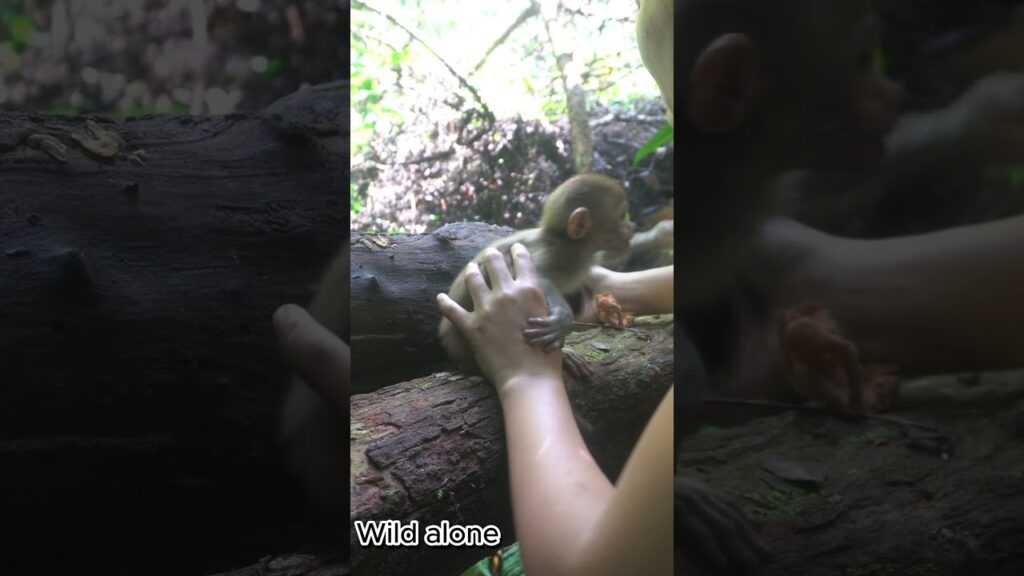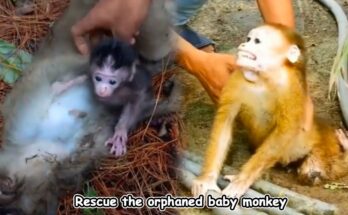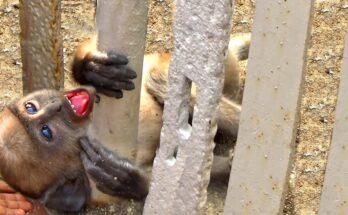The Call of the Wilderness
The forest hums with life—a symphony of rustling leaves, distant howls, and the rhythmic drumming of nature’s heartbeat. For centuries, humans have sought refuge in its embrace, crafting shelters from trees, drinking from pure streams, and learning to live in harmony with the land.
But survival in the wild demands more than just skill—it calls for companionship, trust, and the unwavering bond between beings who depend on each other. This is the story of a Woman who, lost in the depths of an untamed jungle, found solace not in human company, but in an unexpected ally—a monkey who became his closest friend and survival partner.
Finding a Friend in the Wild
Separated from civilization after an accident, the Woman—whom we’ll call Elias—was forced to endure nature’s trials with nothing but his instincts and the tools he carried. Though his training in bushcraft granted him the means to survive, loneliness threatened to consume him.
That was until he met Koto—a curious long-tailed monkey who, despite his mischievous nature, watched Elias closely from the treetops. At first, Koto was wary, maintaining a cautious distance as Elias built his shelter and foraged for food. But soon, the monkey recognized something familiar: Elias was not just another intruder; he was another being fighting to survive.
Over time, their bond grew. Koto observed Elias making fire with flint and dry leaves, sharpening spears to catch fish, and weaving branches together to form a sturdy shelter. The monkey, intelligent and eager, mimicked his actions, learning to use sticks for digging and stones for cracking nuts. Elias, in turn, found companionship—someone to share the struggles and victories of life in the wild.

Building Shelter: The Art of Bushcraft
A shelter is more than protection from the elements—it’s the foundation of survival. Elias understood that if he were to thrive in the jungle, he needed a reliable space for rest, warmth, and security. Using his knowledge, he chose a location near fresh water, far from predators, and surrounded by sturdy trees.
He started by building a lean-to, layering branches against a central pole. Koto watched with fascination, often jumping onto the structure and tugging at vines Elias used for binding. Though initially a distraction, the monkey soon proved helpful—pulling twigs and dropping leaves where Elias needed them.
As days passed, their shelter evolved. A raised sleeping area prevented dampness from seeping through, while woven palm fronds created a roof that shielded them from rain. Elias reinforced the structure with thick logs, and Koto, ever the assistant, learned to recognize when Elias needed extra materials.
Bushcraft became their shared language, a method of survival that bound them together. Elias whispered to Koto as he worked, explaining each step, and though the monkey never spoke, he understood—his actions mirrored Elias’s teachings.
The Hunt for Food: Lessons in Survival
In the depths of the jungle, sustenance is not guaranteed. Elias relied on his skill with traps, fishing, and edible plant identification, while Koto used his natural instincts—climbing high to find ripe fruits, signaling danger when predators lurked.
Hunting required precision. Elias crafted spears from sharpened wood, using techniques taught by survivalists long before him. Koto, agile and swift, became a scout—spotting movement in the underbrush, alerting Elias when prey was nearby.
On days when meat was scarce, they turned to the bounty of the forest. Koto introduced Elias to fruits he hadn’t recognized, pulling apart husks to reveal edible seeds. Elias, in turn, taught Koto which leaves were safe, sharing meals under the vast jungle canopy.
Trust grew between them. Elias depended on Koto’s keen senses just as the monkey relied on Elias’s protection. In a world where survival meant adaptation, their partnership thrived.
Fire: The Spark of Survival
Fire is the heart of any survival story. It provides warmth, wards off predators, purifies water, and turns raw food into sustenance. For Elias, mastering fire meant mastering survival itself.
Using dried moss and a striker stone, he worked tirelessly to create a flame. Friction, patience, and careful feeding of the embers soon rewarded him with a crackling fire. Koto, always observant, watched the dance of flames, mesmerized by the light and heat.
Though cautious, he learned not to fear the fire but to respect it. He sat close on cold nights, sharing the warmth with Elias. They cooked their meals over the embers, drying fish, roasting nuts, and making sure they stayed nourished.
Challenges and Triumphs
Survival isn’t just about crafting tools or finding food—it’s about perseverance through hardship. There were nights when storms raged, tearing leaves from branches and shaking the earth with thunder. Elias and Koto huddled together, shielding their fragile fire, praying the morning would bring clearer skies.
There were days when food ran low, when hunger gnawed at their bellies and desperation tested their will. Elias learned to ration, to stretch meals, and to look beyond his fears—because failure meant starvation.
There were moments of exhaustion, when injury threatened to slow Elias’s movements and when Koto, too, grew weak. But through every challenge, they leaned on one another, pushing forward despite the obstacles.
The Lessons of the Wild
Elias and Koto’s journey was more than a tale of survival—it was a testament to the power of companionship in the face of adversity. Though human and monkey were different in form, their instincts aligned, their struggles intertwined, and their victories shared.
Bushcraft became their language, trust their foundation, and love the unspoken force that kept them moving.
When Elias finally found his way back to civilization, he didn’t leave alone. Koto, his friend, his ally, his brother in survival, remained by his side. Their bond, forged in fire and hardship, was stronger than the barriers of species or language.
And so, Woman and monkey walked together—not as master and follower, but as equals, shaped by the wild and strengthened by love.


